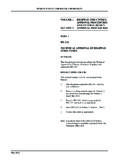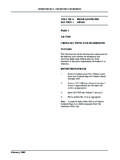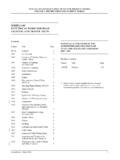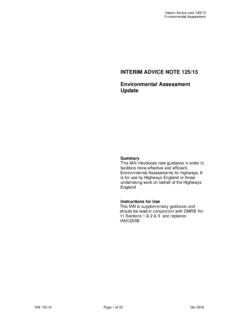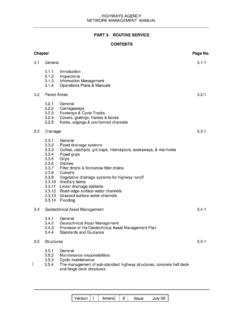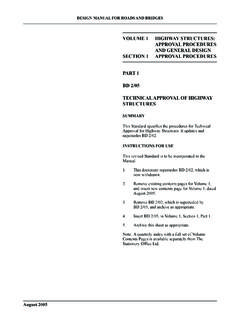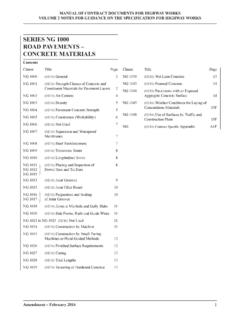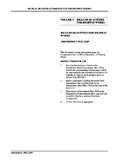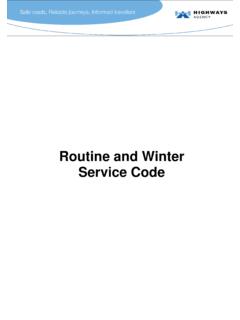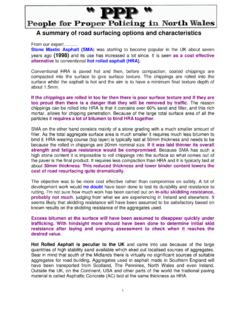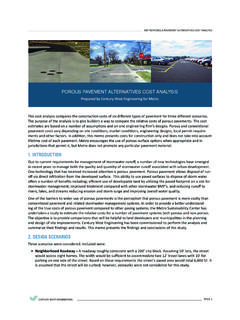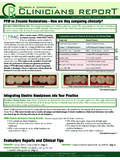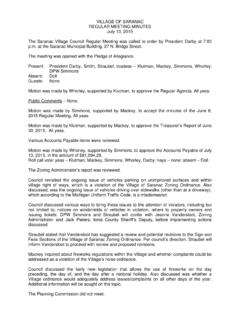Transcription of DMRB VOLUME 7 SECTION 5 PART 1 - HD 36/06 - …
1 November 2006 DESIGN MANUAL FOR ROADS AND BRIDGESVOLUME 7 PAVEMENT DESIGN ANDMAINTENANCESECTION 5 PAVEMENT MATERIALSPART 1HD 36/06 SURFACING MATERIALS FOR NEWAND MAINTENANCE CONSTRUCTIONSUMMARYThis revision primarily updates Chapter 3 of thisStandard. This Standard provides a summary ofsurfacing options available for use on both flexible andrigid pavements and advises on current requirements forsurfacing. It also details requirements for aggregatespreviously covered in HD 28 ( dmrb ) and givesadvice on surface FOR Contents pages from VOLUME 7 andinsert new Contents pages for VOLUME 7 datedNovember HD 36/99 from VOLUME 7, SECTION 5which is superseded by this Stadard and archiveas HD 36/06 into VOLUME 7, SECTION archive this sheet as : A quarterly index with a full set of VolumeContents Pages is available separately from TheStationery Office 36/06 Surfacing Materials for New andMaintenance ConstructionSummary:This revision primarily updates Chapter 3 of this Standard.
2 This Standardprovides a summary of surfacing options available for use on both flexible andrigid pavements and advises on current requirements for surfacing. It alsodetails requirements for aggregates previously covered in HD 28 ( dmrb )and gives advice on surface MANUAL FOR ROADS AND BRIDGESTHE HIGHWAYS AGENCYTRANSPORT SCOTLANDWELSH ASSEMBLY GOVERNMENTLLYWODRAETH CYNULLIAD CYMRUTHE DEPARTMENT FOR REGIONAL DEVELOPMENTNORTHERN IRELANDV olume 7 SECTION 5 Part 1 HD 36/06 November 2006 REGISTRATION OF AMENDMENTSA mendPage NoSignature & Date ofAmendPage NoSignature & Date ofNoincorporation ofNoincorporation ofamendmentsamendmentsRegistration of AmendmentsVolume 7 SECTION 5 Part 1 HD 36/06 November 2006 REGISTRATION OF AMENDMENTSA mendPage NoSignature & Date ofAmendPage NoSignature & Date ofNoincorporation ofNoincorporation ofamendmentsamendmentsRegistration of AmendmentsVOLUME 7 PAVEMENT DESIGN ANDMAINTENANCESECTION 5 PAVEMENT MATERIALSPART 1HD
3 36/06 SURFACING MATERIALS FOR NEWAND MAINTENANCE and Aggregate currently Surface and MANUAL FOR ROADS AND BRIDGESN ovember 2006 VOLUME 7 SECTION 5 Part 1 HD 36/06 November 20061/1 Chapter 1 Introduction1. Part provides a summary of surfacingoptions available for use on both flexible and rigidpavements and advises on current requirements forsurfacings. The Part also details the requirements foraggregates to ensure that satisfactory skiddingresistance is provided on roads and should be read inconjunction with HD 28 ( dmrb ). This Part alsoincludes details of surface texture and how this affectssurface noise at the tyre/road information on bituminousmaterials is given in HD 26 ( dmrb ). Furtherinformation on the maintenance of bituminous roadscan be found in HD 31 ( dmrb ) and in HD 32( dmrb ) for the maintenance of concrete information on bituminous materialtypes, and surfacing processes, together with advice ontheir use, is presented in HD 37 ( dmrb ).
4 Detailsof concrete surfacing and materials are given in HD 38( dmrb ). Reference should be made to theSpecification (MCHW1) Series 700, 900 and 1000,together with the Notes for Guidance (MCHW2). Forsome materials there are British Standards and otherpublished documentation and these are referenced inthe appropriate Part shall be used forthwith on all schemesfor the construction, improvement and maintenance oftrunk roads including motorways, currently beingprepared provided that, in the opinion of the OverseeingOrganisation this would not result in significantadditional expense or delay. Design organisationsshould confirm its application to particular schemeswith the Overseeing construction and maintenance of highwaypavements will normally be carried out under contractsincorporating the Overseeing Organisation sSpecification for Highway Works (MCHW1).
5 In suchcases products conforming to equivalent standards andspecifications of other States of the European EconomicArea and tests undertaken in the other States will beacceptable in accordance with the terms of the 104 and105 Series of Clauses of that Specification. Anycontract not containing these clauses must containsuitable clauses of mutual recognition having the sameeffect regarding which advice should be 7 SECTION 5 Part 1 HD 36/06 November 20062/1 Chapter 2 Surfacing Options2. SURFACING choice of surfacing materials/systems plays avital role in providing roads that meet the needs of theuser, are safe and give value for money. For many yearshot rolled asphalt with chippings rolled into the surfacewas the most widely used surfacing on trunk roads,including motorways, for both new construction andmajor maintenance.
6 However, recent years have seenthe development of new materials and techniques, manyof which are proprietary, which offer significantadvantages not just to the road user but also to theenvironment. For example, noise generation may bereduced, delays at road works curtailed, ride qualityimproved and deformation resistance enhanced, allwhile maintaining existing safety levels. Furthermore,new products such as energy efficient cold-lay materials are in their development phase. This Chaptergives guidance on the range of surfacing options thatare now available for both new construction remove the barriers to trade and to encourageinnovation, the Construction Products Directive (CPD)of the European Union requires the introduction ofperformance related specifications wherever clauses of this type have been included inthe Specification for Highway Works (MCHW1&2)covering surfacings such as surface dressings (Clause922), slurry and micro-surfacings (Clauses 918), highfriction surfacing (Clause 924), (Clause 938), thinsurface course systems (Clause 942) and hot rolledasphalt (Clause 943).
7 Performance is assessed either bytesting samples from the laid material, testing the laidmaterial in-situ or, for proprietary systems, byassessment and approval under the British Board ofAgr ment Highway Authorities Product ApprovalScheme (BBA HAPAS). BBA HAPAS certification isspecified but certificates are not in place, or inEngland, HA type approval has not been given, theapproval of the Overseeing Organisation must besought and a Departure of from the suitability of surfacing materialsin terms of safety and robustness, the permittedpavement surfacing options for use on trunk roads, havebeen determined by the Overseeing Organisations, asindicated in Tables (E), (S), (NI) and (W), takingaccount of the variations across the UK of a number offactors: the nature of the existing network; population density; traffic intensity; climatic conditions.
8 Availability of decision on which permitted options are tobe included should be made on a site-specific basis butnone should be ruled out without justification. Inlocations where speeds are limited and tyre/roadgenerated noise low, or where traffic intensity andtherefore the overall noise level is not very great, thenthe full range of suitable surfacings should noise levels are high due to the intensityof high-speed traffic, surfacing materials are availablethat can significantly reduce tyre/road generated noiseemission compared to hot rolled asphalt. These includehot, paver-laid thin surface course systems,Specification Clause 942 (MCHW 1). on the different types of surfacings isgiven in HD 37 and 38 ( dmrb & 3). Althoughinformation on various surfacings and treatments isprovided in HD 37 and HD 38, it should not beassumed that their use is permitted on the trunk roadnetwork.
9 Advice is provided for certain treatments forinformation only. Reference should be made to to check permitted 7 SECTION 5 Part 1 HD 36/06 November 2006 This table is for usein Englandonly2/2 Chapter 2 Surfacing England, no surface treatment should beconsidered without taking into account theHighways Agency s requirements for low-noisesurfacing. Retexturing of existing surfaces is notpermissible without Departure approval. Thisapproval will not be unreasonably withheld forsmall lengths of pavement with a particularskidding or other safety surfacing options permitted shall bethose shown in Tables , and , forEngland, Northern Ireland and Wales an option is permitted with DepartureRequired , a Departure from Standard will berequired from the Overseeing construction typesUse without restrictionDeparture requiredNewYesThin Surface Course SystemPorous AsphaltConstructionorNoHighYesThin Surface Course SystemHot Rolled AsphaltMajor(minor)speed?
10 Porous AsphaltMaintenance?(85%ileSurface Dressingabove 65 Exposed Aggregate Concretekm/hr)(note 1)Brushed/Burlap Drag/TinedConcrete (note 1)NoThin Surface Course SystemHot Rolled AsphaltPorous AsphaltSurface DressingSlurry/MicrosurfacingExposed Aggregate Concrete(note 1)Brushed/Burlap Drag/TinedConcrete (note 1)Note 1: Rigid construction onlyTable (England): Permitted Pavement Surfacing Materials forNew and Maintenance ConstructionFor Table , for use in Scotland, where anoption is permitted subject to Approval toProceed , such approval is required from theOverseeing In Table , high-speed roads are defined asthose with an 85th percentile traffic speed exceeding 65km/hr. The various pavement construction types aredefined in HD 26 ( dmrb ).
